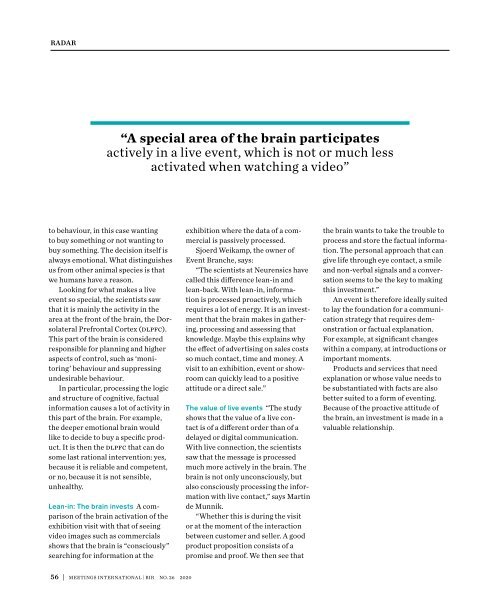meetings-international 26
You also want an ePaper? Increase the reach of your titles
YUMPU automatically turns print PDFs into web optimized ePapers that Google loves.
RADAR<br />
“A special area of the brain participates<br />
actively in a live event, which is not or much less<br />
activated when watching a video”<br />
to behaviour, in this case wanting<br />
to buy something or not wanting to<br />
buy something. The decision itself is<br />
always emotional. What distinguishes<br />
us from other animal species is that<br />
we humans have a reason.<br />
Looking for what makes a live<br />
event so special, the scientists saw<br />
that it is mainly the activity in the<br />
area at the front of the brain, the Dorsolateral<br />
Prefrontal Cortex (DLPFC).<br />
This part of the brain is considered<br />
responsible for planning and higher<br />
aspects of control, such as ‘monitoring’<br />
behaviour and suppressing<br />
undesirable behaviour.<br />
In particular, processing the logic<br />
and structure of cognitive, factual<br />
information causes a lot of activity in<br />
this part of the brain. For example,<br />
the deeper emotional brain would<br />
like to decide to buy a specific product.<br />
It is then the DLPFC that can do<br />
some last rational intervention: yes,<br />
because it is reliable and competent,<br />
or no, because it is not sensible,<br />
unhealthy.<br />
Lean-in: The brain invests A comparison<br />
of the brain activation of the<br />
exhibition visit with that of seeing<br />
video images such as commercials<br />
shows that the brain is “consciously”<br />
searching for information at the<br />
exhibition where the data of a commercial<br />
is passively processed.<br />
Sjoerd Weikamp, the owner of<br />
Event Branche, says:<br />
“The scientists at Neurensics have<br />
called this difference lean-in and<br />
lean-back. With lean-in, information<br />
is processed proactively, which<br />
requires a lot of energy. It is an investment<br />
that the brain makes in gathering,<br />
processing and assessing that<br />
knowledge. Maybe this explains why<br />
the effect of advertising on sales costs<br />
so much contact, time and money. A<br />
visit to an exhibition, event or showroom<br />
can quickly lead to a positive<br />
attitude or a direct sale.”<br />
The value of live events “The study<br />
shows that the value of a live contact<br />
is of a different order than of a<br />
delayed or digital communication.<br />
With live connection, the scientists<br />
saw that the message is processed<br />
much more actively in the brain. The<br />
brain is not only unconsciously, but<br />
also consciously processing the information<br />
with live contact,” says Martin<br />
de Munnik.<br />
“Whether this is during the visit<br />
or at the moment of the interaction<br />
between customer and seller. A good<br />
product proposition consists of a<br />
promise and proof. We then see that<br />
the brain wants to take the trouble to<br />
process and store the factual information.<br />
The personal approach that can<br />
give life through eye contact, a smile<br />
and non-verbal signals and a conversation<br />
seems to be the key to making<br />
this investment.”<br />
An event is therefore ideally suited<br />
to lay the foundation for a communication<br />
strategy that requires demonstration<br />
or factual explanation.<br />
For example, at significant changes<br />
within a company, at introductions or<br />
important moments.<br />
Products and services that need<br />
explanation or whose value needs to<br />
be substantiated with facts are also<br />
better suited to a form of eventing.<br />
Because of the proactive attitude of<br />
the brain, an investment is made in a<br />
valuable relationship.<br />
56 | MEETINGS INTERNATIONAL | BIR No. <strong>26</strong> 2020

















